Exploring the Ollantaytambo ruins at the far end of the Sacred Valley of the Incas
Close before Machu Picchu, at the far end of the Sacred Valley of the Incas hides a precious gem only a few tourists to Peru have on their radar: Ollantaytambo. The ancient Inca fortress was built around the middle of the 15th century and is the second most well-preserved ruin in Peru (third would be Pisac, click to read my guide)
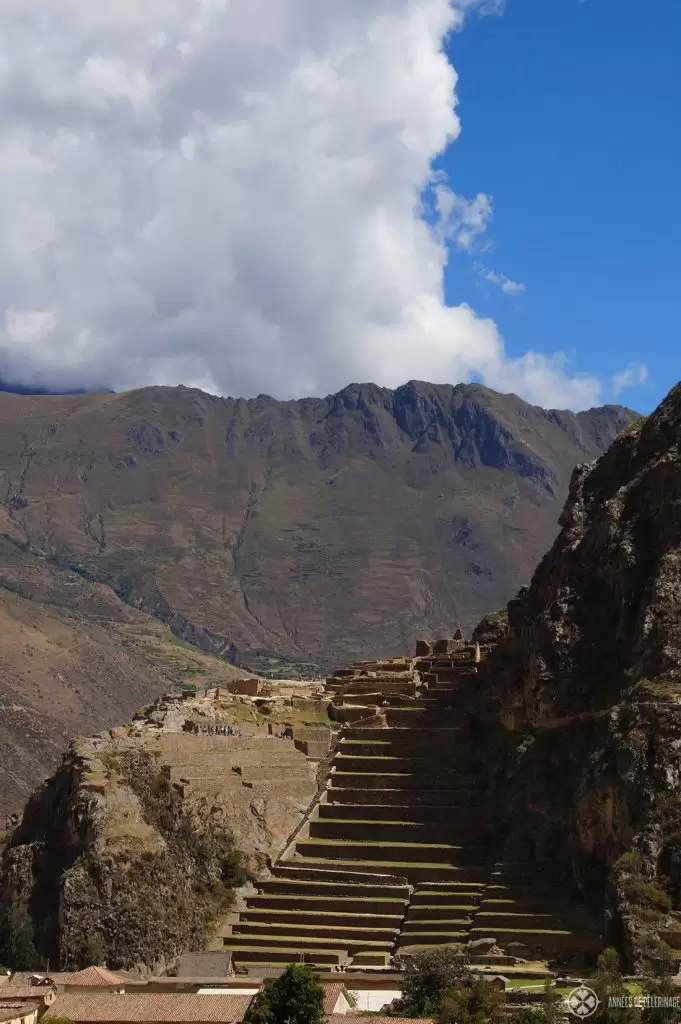
For me, the ruins are the best alternative to Machu Picchu. Hold on: you really should try to see Machu Picchu (make sure to read my guide). But sometimes money or ticket vacancies won’t permit it, and the Ollantaytambo ruins are just as beautiful and so much easier to visit! That being said, I do recommend to visit both! And in case you can’t get enough of ancient history, here are the top 10 Inca ruins to visit in Peru.
Quick facts about Ollantaytambo
- Opening hours: 7 am to 6 pm (all year)
- Entry price: 130 Soles (Boleto turistico for several Inca sites)
- Altitude: 2,792 m (9,160 ft)
- Distance to Cusco: 70 kilometers
- Distance to Machu Picchu: 30 kilometers
Things to do in Ollantaytambo – a visual walking tour
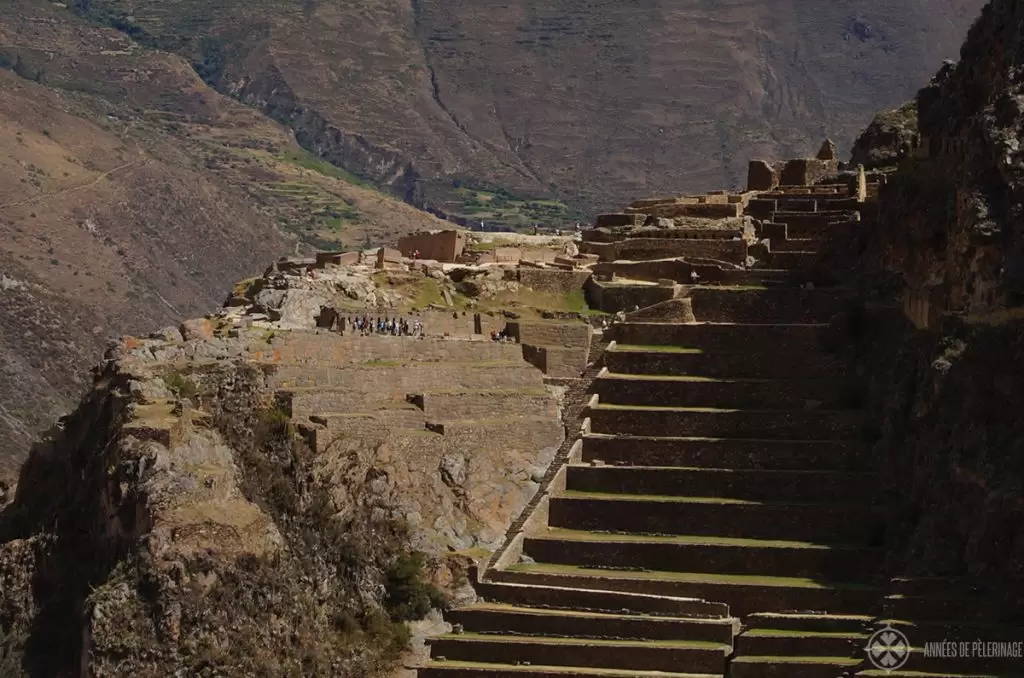
Ollantaytambo is separated into 4 distinct areas: The ancient town, the temple hill, the ceremonial area and the agricultural sector. While there are yet other things to do in Ollantaytambo, the Inca ruins really are the reason you should visit. You will probably need almost a full day to tour to see it all. Decide for yourself what you want to see and what to skip if you are short on time. Do consider, though, that with an altitude of 2,792 meters you will have to take things a bit slower than usual.
Note: Check out my list of the top 10 day trips from Cusco for further inspiration.
The temple hill & fortress of Ollantaytambo (Cerro Bandolista)
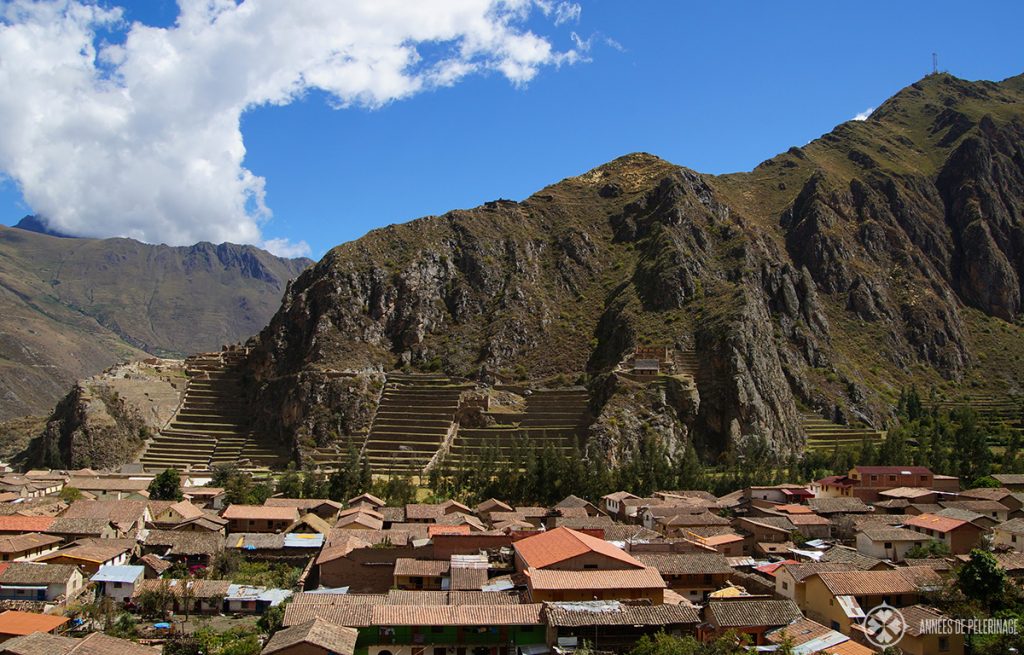
The most prominent feature in Ollantaytambo is certainly the temple hill. It is said, the hill was built in the shape of a lama – at least you will hear this tale from probably every local guide. If you take a close look at Ollantaytambo from the opposite mountain, it is actually possible to see the lama quite clearly: Head, four legs, and a little tail. Okay, with a lot of fantasy ;-)
Right from the entrance to the site, the ruins of Ollantaytambo climb up into the terraced heights of a temple district. It is often called a fortress, but only a very small portion of the structures actually served a military purpose.
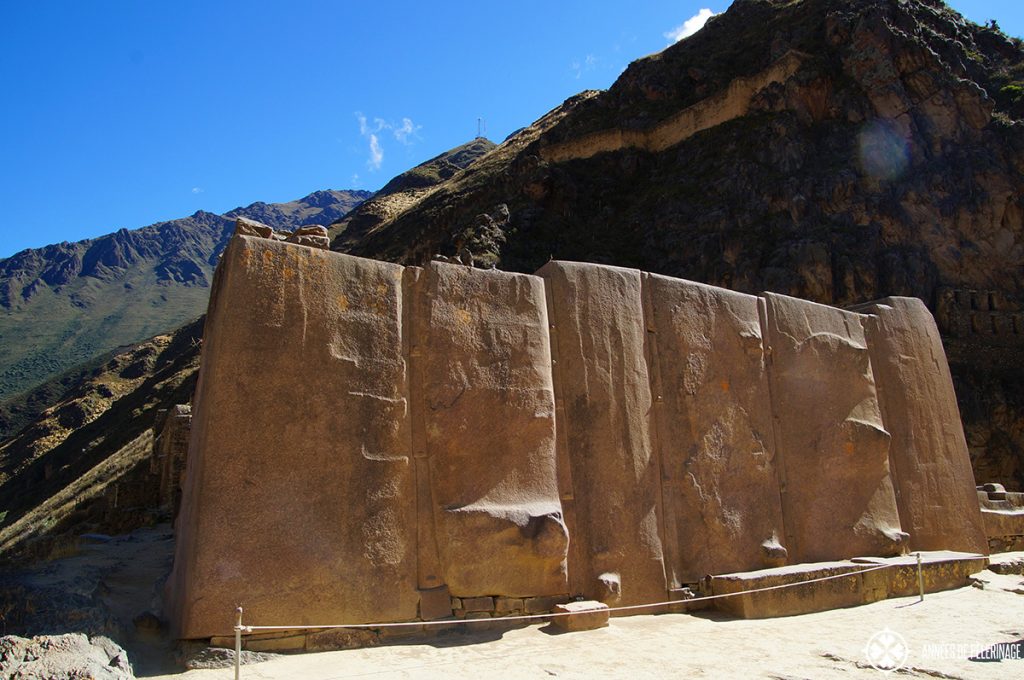
Take your time hiking to the top. The severe height will take away your breath quite quickly. As the vistas around you are just so beautiful, you will want to take a lot of breaks anyhow. At the top, the wall of the Six Monoliths will dominate the view.
The temple was never finished but probably belonged to a Templo del Sol – a temple to worship the sun. Each stone is said to weigh more than 50 tons. How these monoliths were transported to this spot from the quarry in on piece remains a mystery.
Nobody really knows why the construction stopped. But it’s probably connected to the fact that Manco Inca retreated to Vilcabamba to escape the onslaught of the Spanish invaders (see more below).
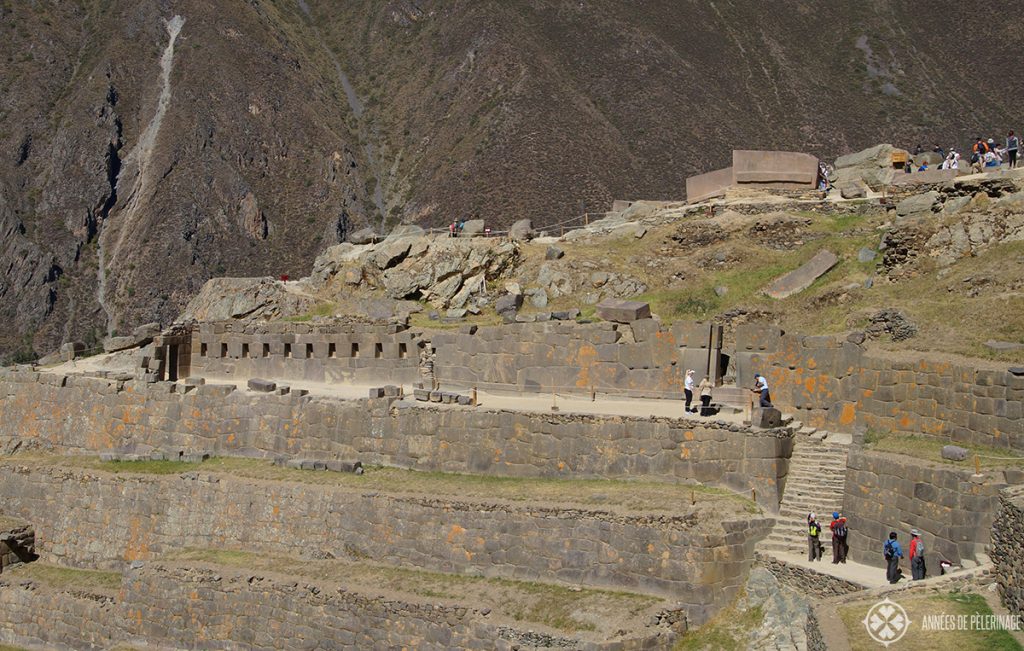
Another smaller, but equally noteworthy site right at the top of Ollantaytambo is the Enclosure of the Ten niches. It looks a bit like a row of windows.
Sanctuary doorway & Intihuatana
To the right, a beautiful doorway guards the entrance to this sacred area. The sheer craftsmanship of the arch will take your breath away. Each stone fits perfectly on the other. Most tourists don’t follow the winding path up to the Intihuatana at the top. To be quite honest, the climb is not really worth it.
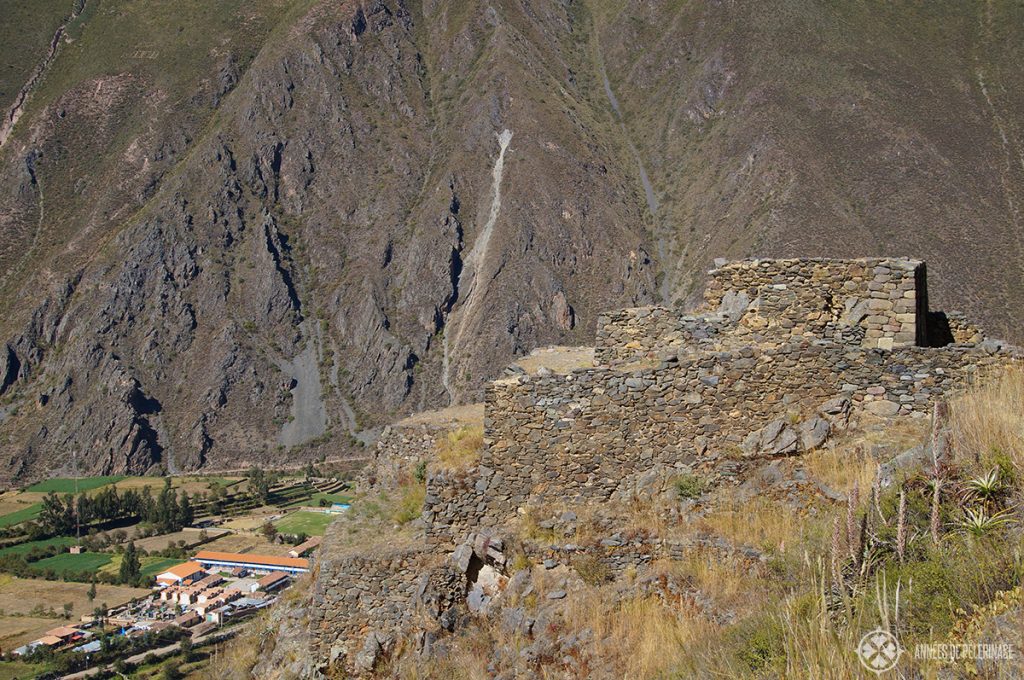
It will take roughly 30minutes both ways. At the very top, the remains of a very small structure can be found. The view was, much to my dismay, not particularly noteworthy either. Still, it’s one of the regions of the ruins you will have all to yourself.
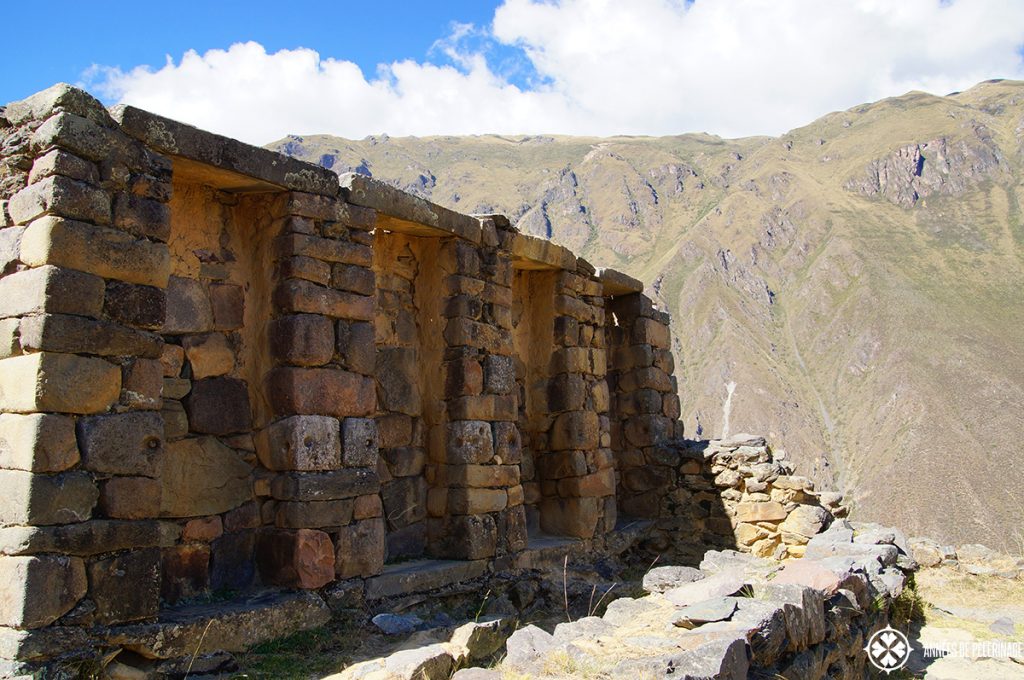
The name intihuatana implies that once a ritual stone was to be found here. Whether the stone has been razed by the Spanish (like in so many other sites except Machu Picchu), or the site served a totally different purpose, I do not know. I feel that Ollantaytambo never really received the archeological focus the ruins actually deserve.
The Terraces and Granaries
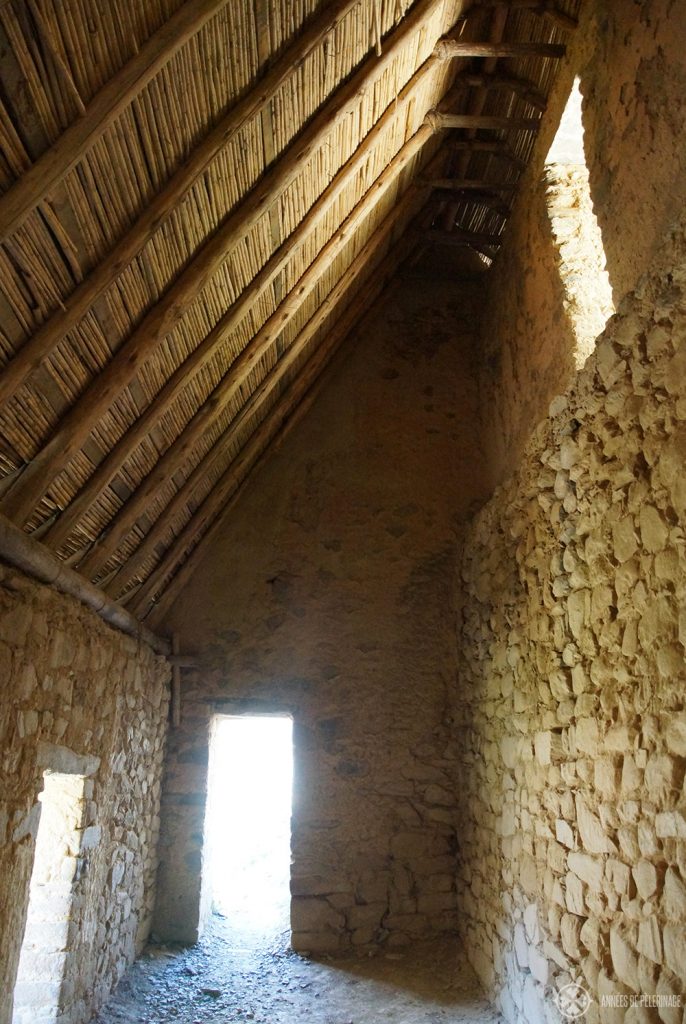
Following the path at the very top of the ritual sector, you will pass the small garrison into the agricultural sector through the so-called “Balcon pata”. This part is quite interesting, as a couple of ancient granaries (Qolqas) have been reconstructed and you can actually go inside.
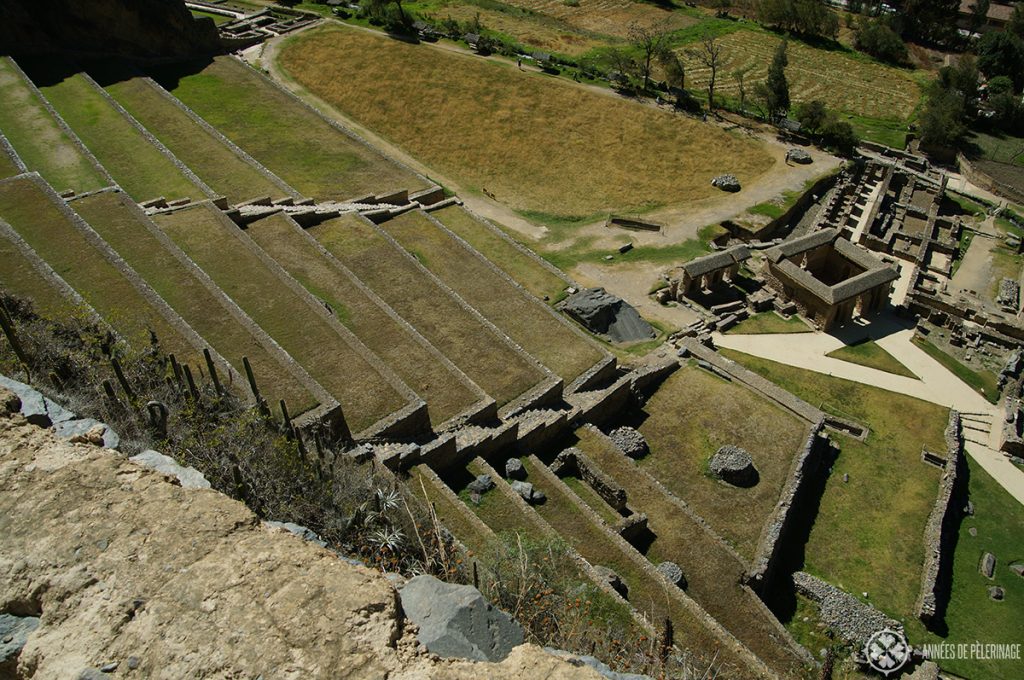
As for the rest, there are just more picture-perfect terraces where the Inca once had planted corn and potatoes. But to be quite honest with you, I had the impression that the terraces at Ollantaytambo were the most meticulously laid ones in Peru. Maras, Pisac, Tipon or Machu Picchu – the terraces here are somewhat more perfect in their shape.
The ritual sector (Araqama Ayllu)
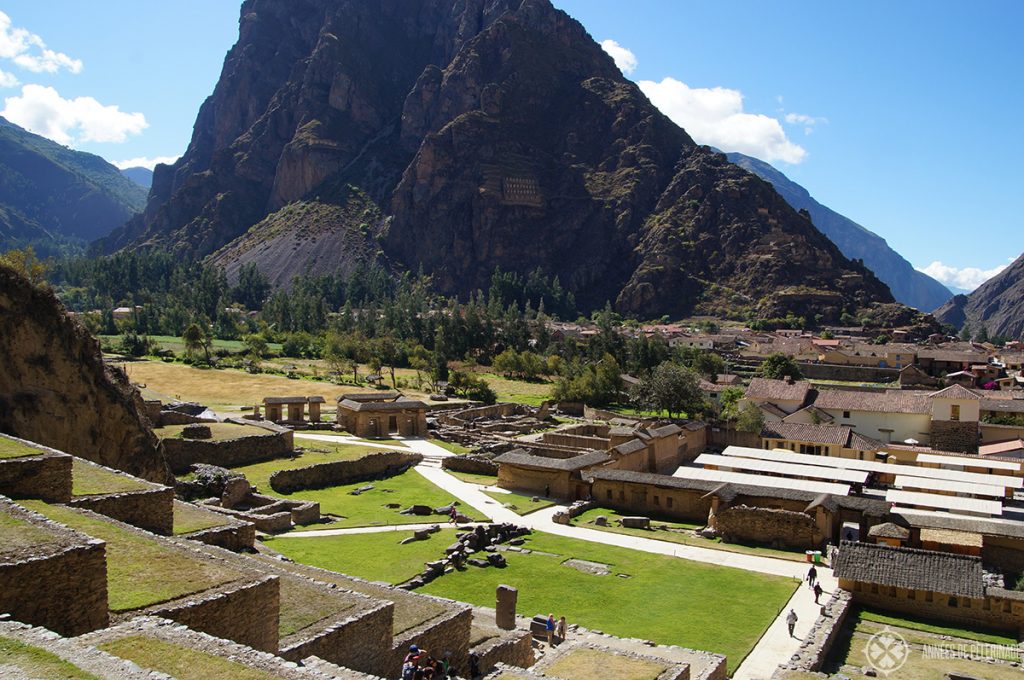
You are able to climb down into the ritual sector from the back of Ollantaytambo. There is no need to go all the way back to the Templo del Sol. In fact, you will be able to see the very origin of the spring that feeds the whole complex this way.
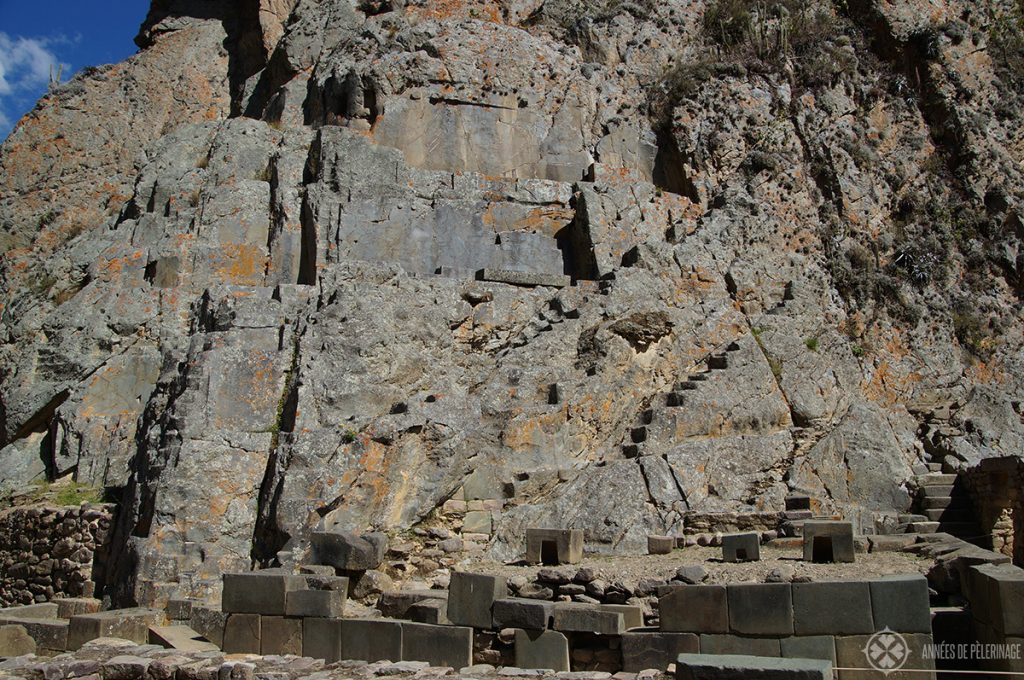
This small ritual site at the far end of Ollantaytambo has, again, a feeling of unfinishedness. It looks more like a quarry, though the remains of the buildings clearly indicate there was more to the site. The official map calls it Incamisana, indicating that it was once a water temple.
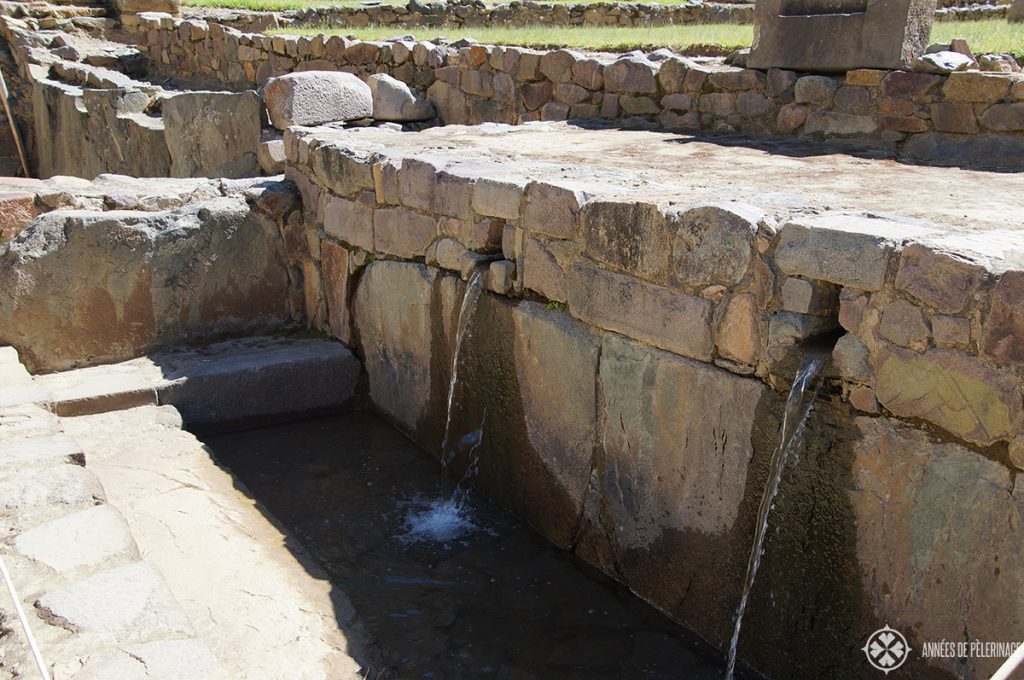
Follow the gurgling sound of the water through the artificial channels and fountains to the actual Templo del Aguas. There is a deeper story to the hydraulic masterpiece the Incas created here (check out this book by Kenneth R. Wright to learn more about it ).
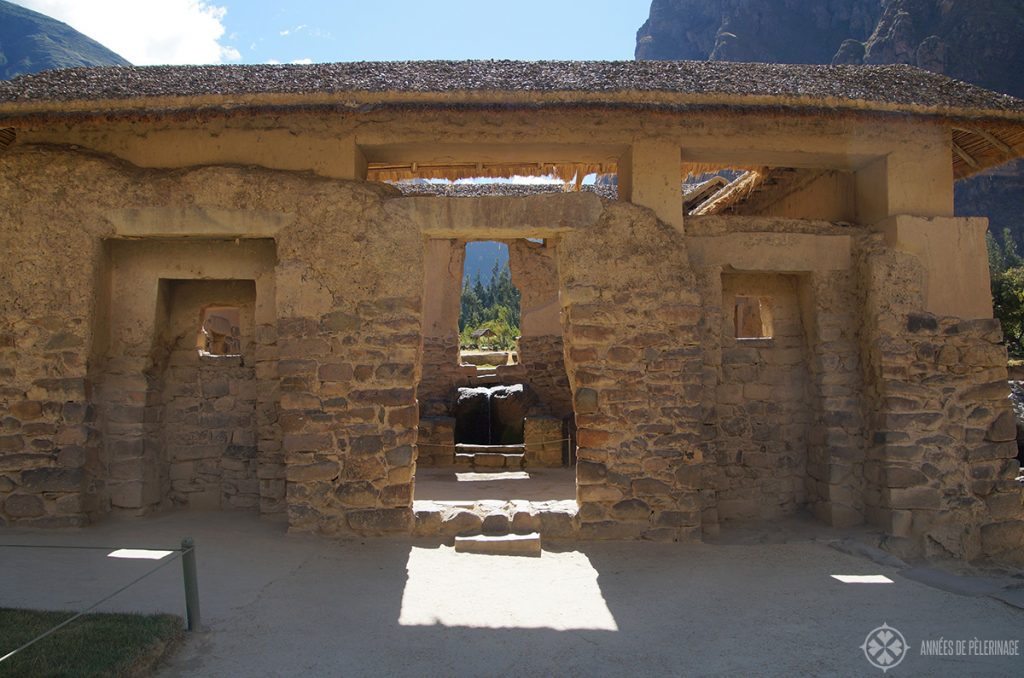
The temple has been reconstructed, but the perfect fountains around are still in its original state. A flood preserved the structure under the alluvial soil in 1679. Only in 1980, the complex water system has been rediscovered.
A quick glance at the tourist map will show you the final highlight of the main ruins of Ollantaytambo the Bath of the Princess (Baño de la ñusta). What differentiates this fountains from all the others in the whole Inca Kingdome is the artful outflow. Not even in beautiful Tipon will you find such elaborate carvings!
Exploring the old town of Ollantaytambo
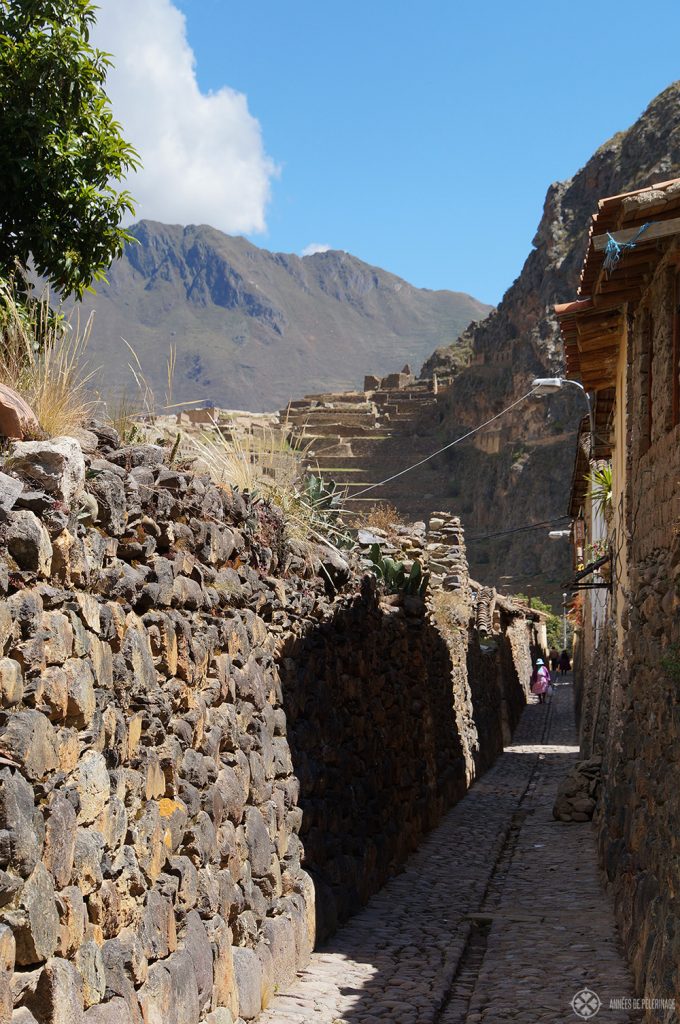
The perhaps most impressive aspect of Ollantaytambo aren’t the actual ruins. The houses the Inca emperor Pachacutec once built in the middle of the 15th century are still there! If you walk through the old part of the town, you will feel like walking down in history. Big cobbled stones line the perfect rectangular grid of the narrow streets.
The houses have the most amazing foundations and every so often you see the locals going about their business in the cool courtyards within. One source I found said these were the oldest, continuously inhabited buildings in South America. While I am not quite sure this is true, it has the sound of it, as most other South American cultures didn’t leave behind such permanent structures built from stone.
Either way, just enjoy the scenery. There are even a couple of hostels and guesthouses to be found in the old part of Ollantaytambo, so you might want to decide to actually stay a night!
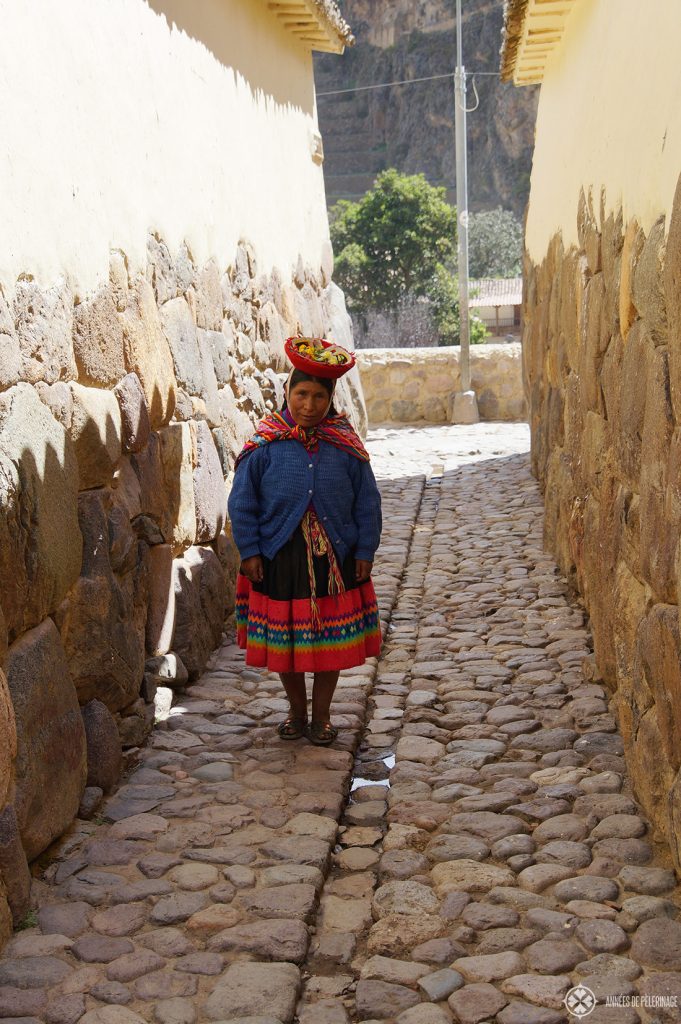
A word of warning: You will find quite a lot of women and young boys running around in traditional garments, sometimes even holding lama or alpaca babies. They prey on your tourist instinct to want a picture with them and will expect a couple of Soles in return.
Personally speaking, I really have to admit that this is probably not the most authentic picture you will shoot. On a more positive note, this is also quite the progressive approach. Here, in Germany, the law prohibits you from taking pictures of anyone without their permission. By paying a few Soles you are actually giving them back a fair share for the hm….exploitation of their personal rights.
Exploring the Pinkuylluna
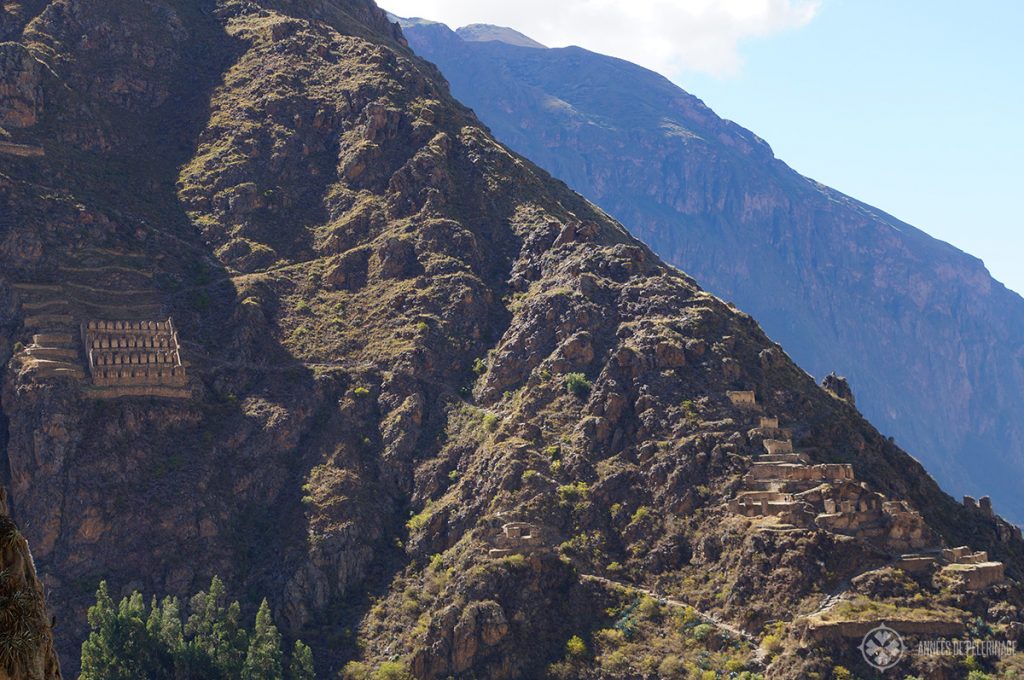
Opening hours: 7:00 am to 4:30 pm
I already mentioned that there is a last and fourth beautiful site in Ollantaytambo you have to explore. Right opposite of the main hill, there are more storehouses called Pinkuylluna. The small path starts right at the bottom in a side alley of Ollantaytambo. The entrance is not that easy to find, but a small official sign is attached to the doorway.
For me, Pinkuylluna was the most spectacular part of Ollantaytambo. How the Incas were able to build houses on such a steep ravine, is beyond me. The reason they did it, seems quite clear. The food was an essential part of any military campaign and thus needed special protection.
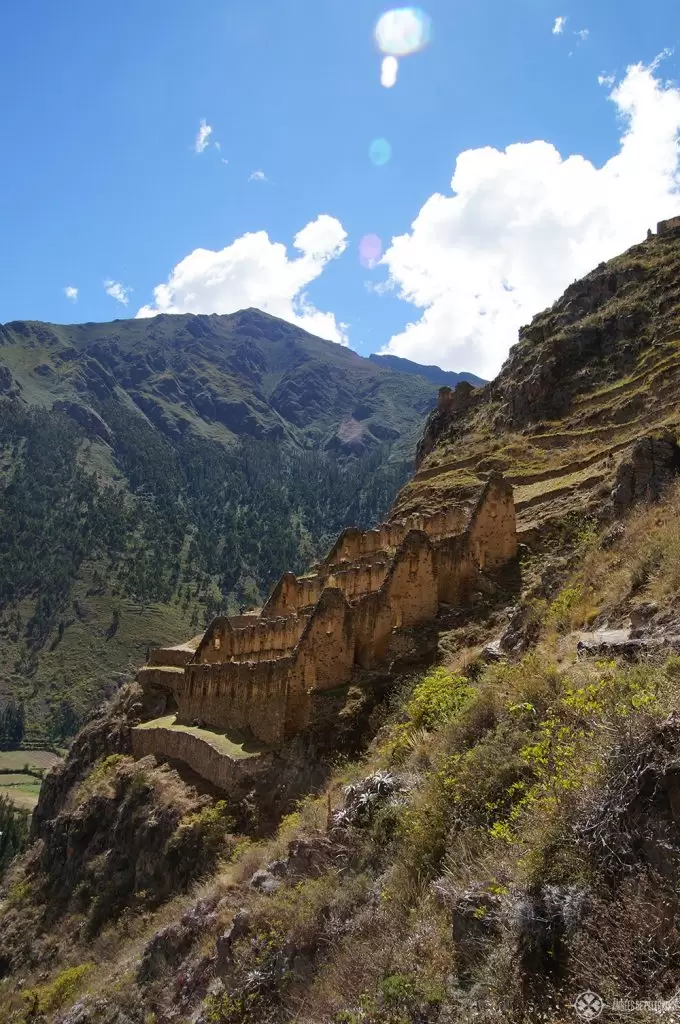
Built on such a high vantage point, it would have been possible to defend the structure with a mere handful of warriors against a whole army. There is also more wind (providing circulation inside the granaries) and a lower temperature.
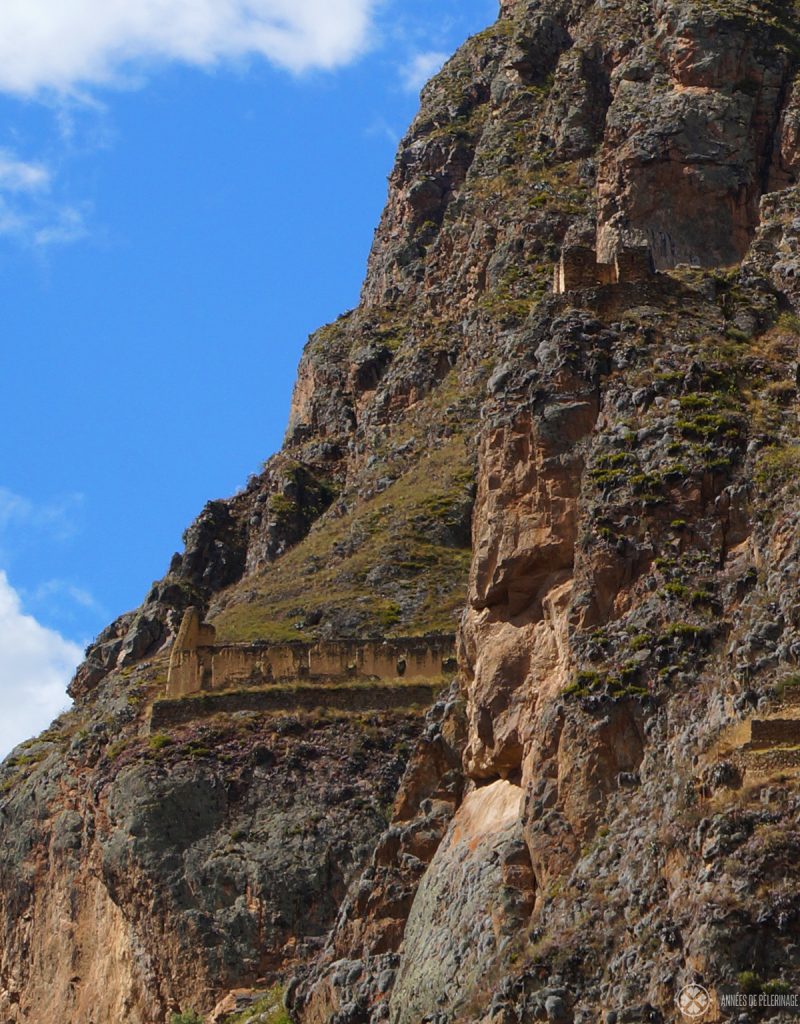
If you take a second look at the rock formations to the side, you might spot the carved face of Viracocha – the great creator of the Inca mythology. Personally speaking, I have my doubts that the Incas, and not centuries of erosion, create the monumental face. I could find no archeological research supporting this claim. It still is a fascinating story you will often hear from the local guides.
Map of Ollantaytambo
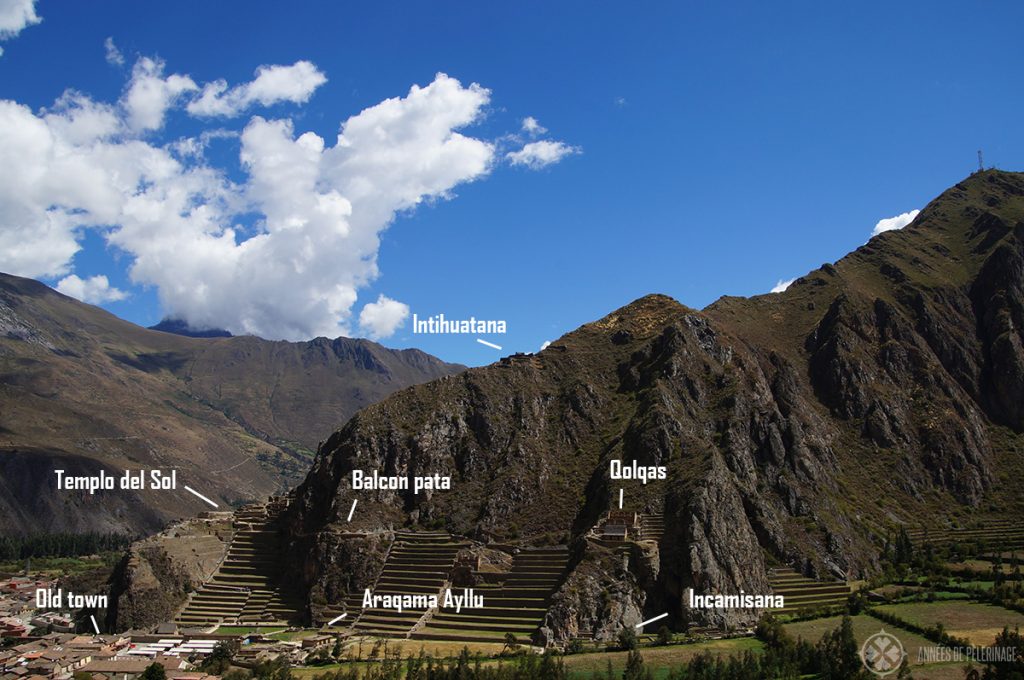
There are small tourist maps available at the entrance of Ollantaytambo and there are a couple of signs that will guide you through the site. Still, I felt like I should provide you with a more visual means to explore the site. Hope it helps! :) There are simple paths interconnecting the different sites.
How to get from Cusco to Ollantaytambo
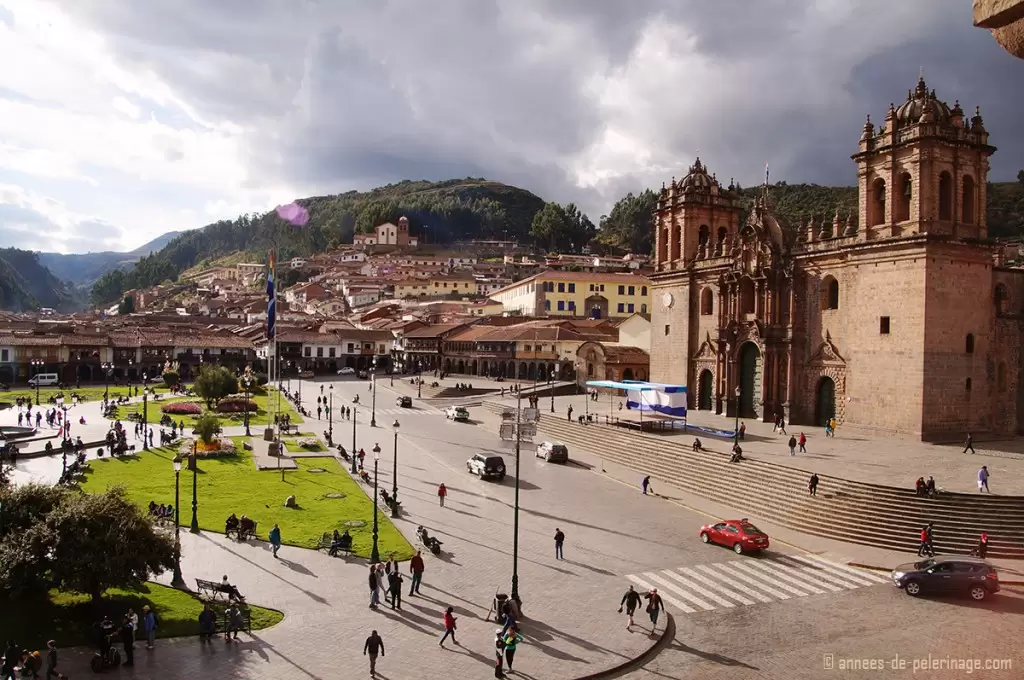
Now, having shown you all these pretty pictures, you are probably wondering how to get there. Ollantaytambo is some 70 kilometers away from Cusco, where most travelers probably start out their adventure through Peru. As the Sacred Valley is both a tourist’s favorite and a well-settled area in Peru, you really got plenty of options to get from Cusco to Ollantaytambo.
There are regular trains leaving from Cusco multiple times a day. These trains are actually heading towards Machu Picchu and will be full of tourists. But nothing speaks against leaving them in Ollantaytambo.
There are also a couple of bus companies. If you want it dead cheap, you can look for one of the many colectivos (group taxis) – but that’s probably no option if you got a lot of luggage or valuables with you?
The maybe best option to get from Cusco to Ollantaytambo might be by car. There are many beautiful Inca ruins on the way (e.g. Maras Salt Mines or Pisac) and it will give you the opportunity to explore them at your own leisure.
How to get from Ollantaytambo to Machu Picchu
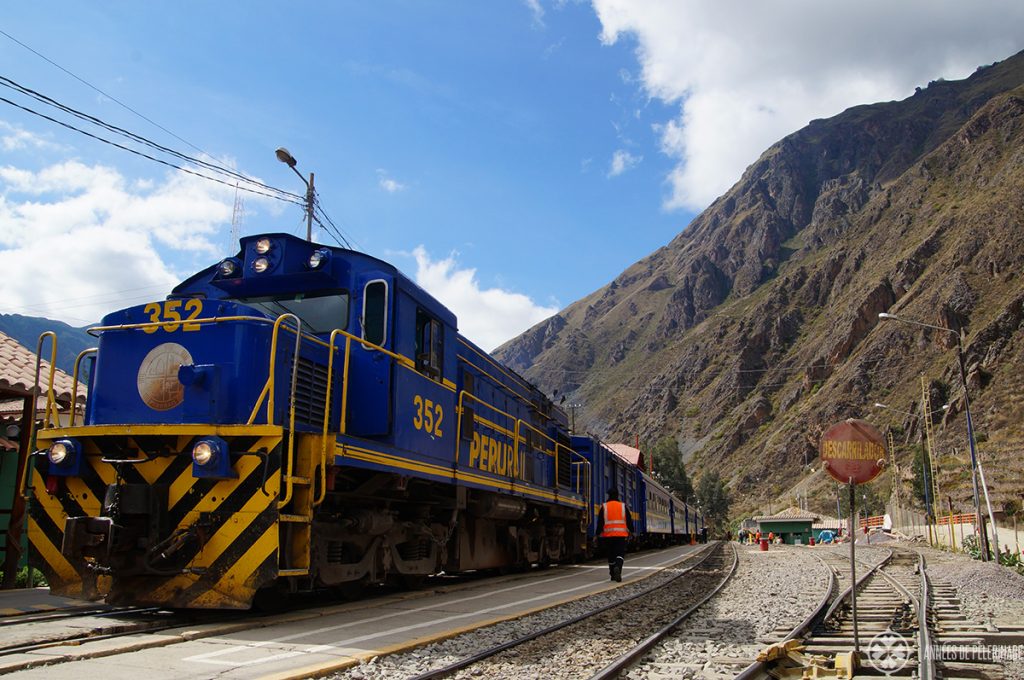
A lot of people decide to stop over in Ollantaytambo before they move onwards to Machu Picchu. The ruins are only about 30 kilometers away, but actually far from easy to reach. You really just got two options: Take the train or walk. There is no road that will get you to Machu Picchu from here (There is one that will get you close, but that’s through Santa Teresa on the other side of the mountains).
Trains leave multiple times per day from Ollantaytambo to Machu Picchu. You got different options, but I recommend you to take the Vista Dome by PeruRail. It has the largest windows and the slow journey down the narrow train tracks is truly outstanding! Tickets are quite expensive, though.
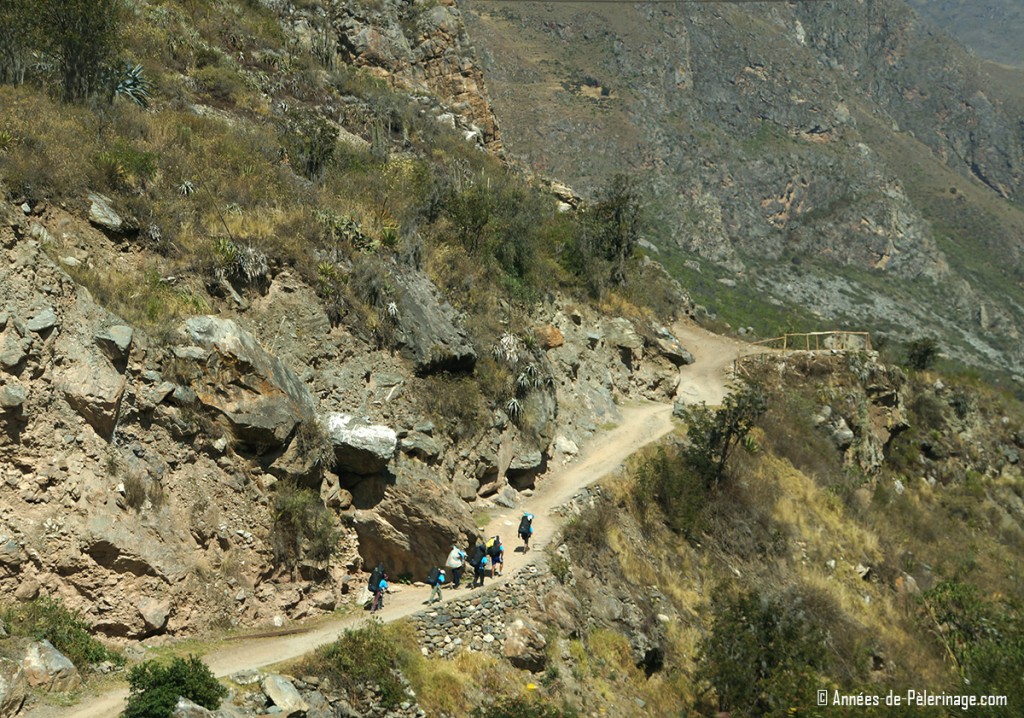
If you don’t want to take the train, you can also opt to do the Inca Trail. The classic trail starts at kilometers 82 of the train tracks not too far from Ollantaytambo and most tourist agencies will be happy to pick you up in town (mostly very early in morning). Be aware that you will need a ticket for the Inca Trail as well and it will take you 4 or 5 days to reach Machu Picchu (compared to the train this is actually the more expensive option).
Here is a more comprehensive article on how to get to Machu Picchu.
Hotels in Ollantaytambo
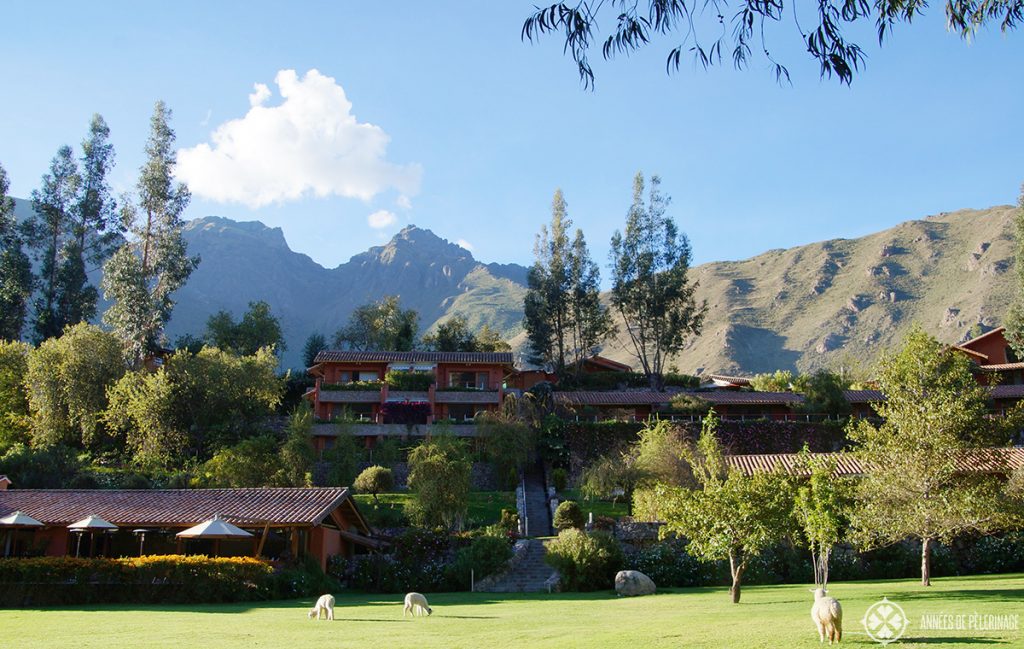
Ollantaytambo really is a little backwater town and you can’t expect to find any hotel worth its name here. There are a couple of hostels and there are a couple of small hotels. As I love to travel in style, none of the hotels in Ollantaytambo were truly appealing to me. But despair not. Not very far, in the middle of the route to the town of Urubamba, you will find the Belmond Rio Sagredo luxury hotel.
I stayed there 3 nights and have to say it is truly the most beautiful property in the whole Sacred Valley. The unique luxury hotel recreates the setting of a small Inca village and is furnished like one as well (okay…well more like an Inca palace ?). I didn’t have the time to type down a detailed review, but I still urge you to go.
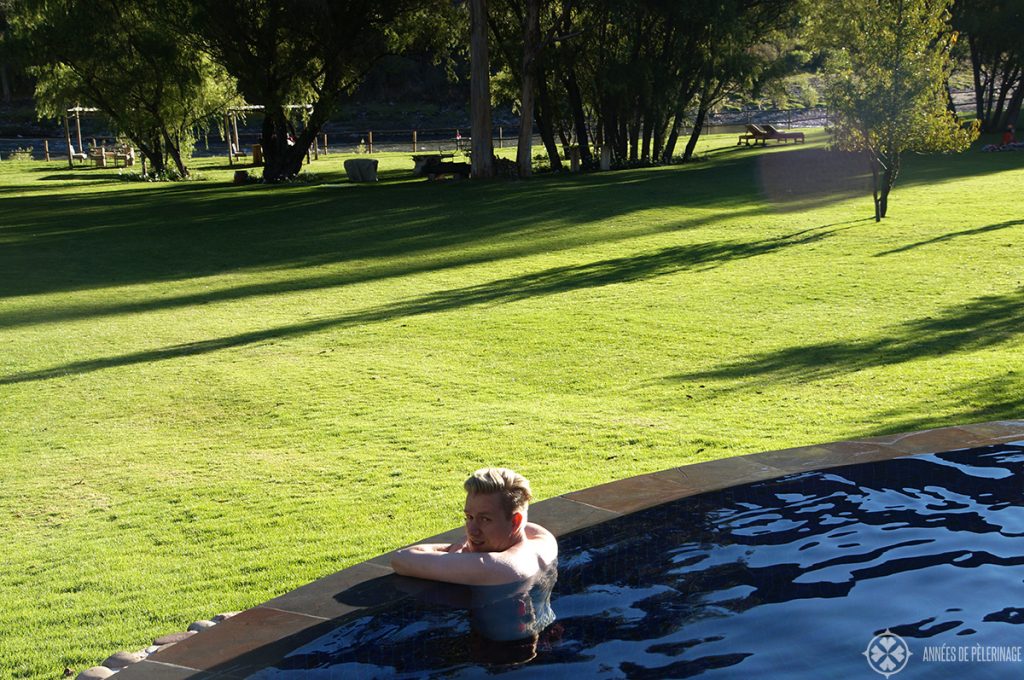
They have the most amazing heated outdoor pool (quite the rarity at 3,000 meters above sea level!) and even alpacas roaming the beautiful gardens. The Maras Salt mines are in walking distance and Ollantaytambo is only a short taxi ride away. Do go.
Check out prices and more pictures here >>
The meaning of the name Ollantaytambo
Ollantaytambo – what a name! The first time I visited it took me about 3 days to get it right. Ollan-tay-tambo. The local Quechua attribute the name to the word tampu, which means “city that offers accommodation, food and comfort for travelers” and Ollanta – a famous Inca captain.
According to the oral tradition, Ollanta fell in love with the Daughter of the King (probably Pachacutec; 1438-1471). As Ollanta didn’t belong to the high ruling class, she was off limits, even though he was a distinguished warrior with many deeds to his name. As the king forbade him to marry his daughter, he then went to the place now called Ollantaytambo and started a rebellion. He was later captured, but at that time Pachacutec was already dead and his son, the new sovereign, allowed the marriage between the two.
Now, I have to stretch that this is only one theory. The Aymara see a connection to the word ulla-nta-wi, “place to look down” or “watchtower”. Everyone who has once been to Ollantaytambo will easily concede that the high fortress is the ideal vantage point over that part of the sacred valley.
But there is yet more. Ollantaytambo was founded AFTER the beginning of the Spanish conquest. So, this is one of the rare cities we have somewhat reliable sources. In the old texts from Eloirreta Salazar, the name Pacaritanpu is given. This translates roughly to “House of the Dawn” or “House of Windows”.
With all things Inca, the truth lies probably somewhere in between.
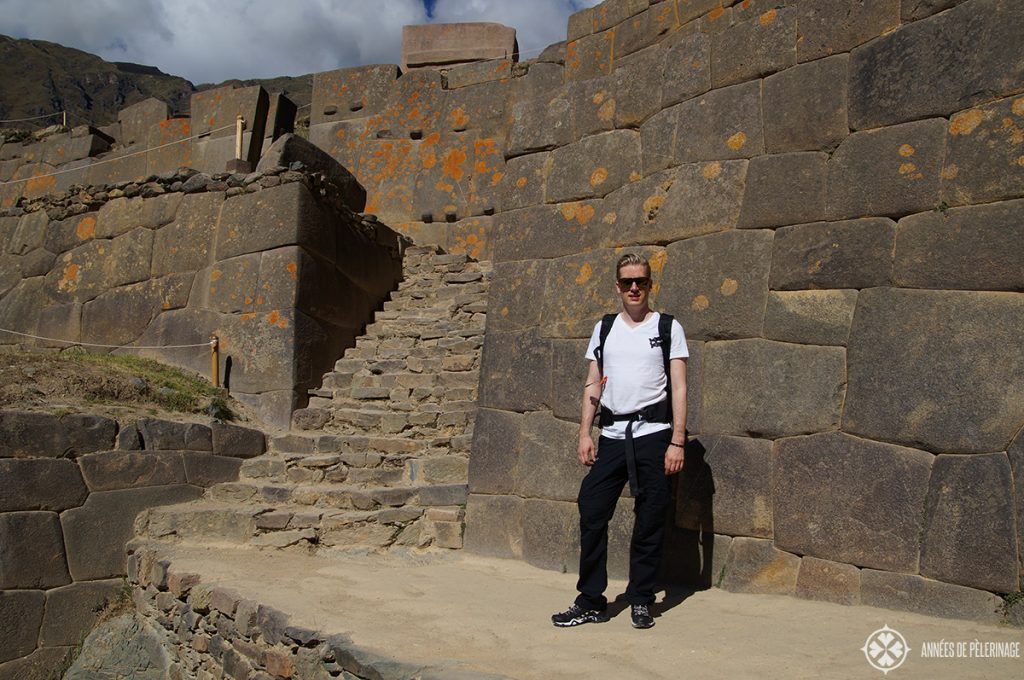
Ollantaytambo history (short version)
The region of the Sacred Valley where Ollantaytambo is located now has been settled long before. However, in the mid 15th century the Inca emperor Pachacuti conquered this part and razed everything he found and incorporate the site into the empire. He commanded the building of extensive terraces and irrigation system, as well townhouses for the Inca nobility.
With the onset of the Spanish invasion, Ollantaytambo was reshaped into a fortress and served as the temporary capital for the Manco Inca for a short period. Before retreating to the fabled Vilcabamba, Ollantaytambo was the last real stronghold of the Inca kingdom in Peru. Despite initial victories again the Spanish expeditions, he retreated to Vilcabamba. By 1540 Ollantaytambo was under the rule of Hernando Pizarro.
Okay, that’s it. That was my guide to the Ollantaytambo ruins in Peru, the maybe best alternative to Machu Picchu. Still got any questions? Ask them in the comments below. And don’t forget to pin this article for later!
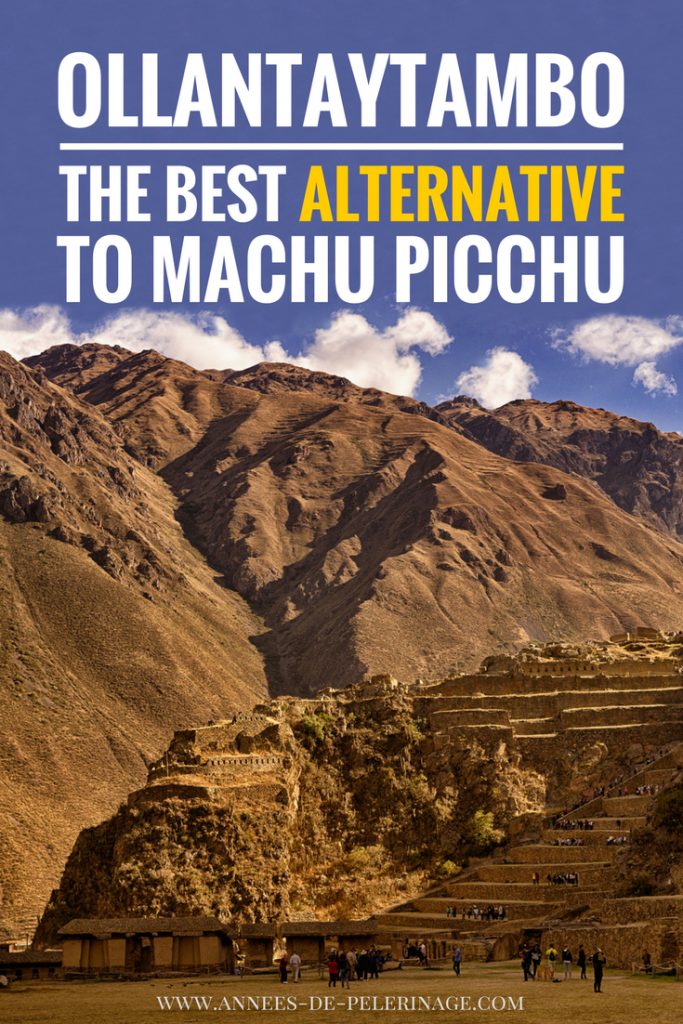


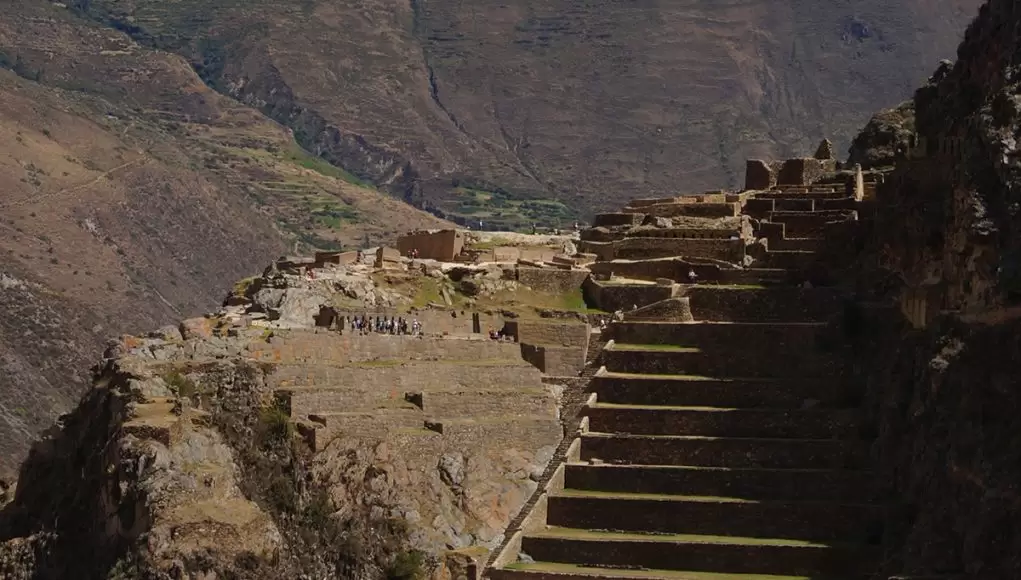
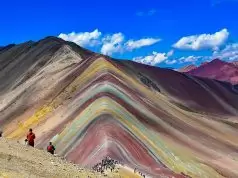
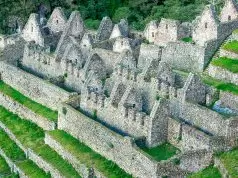
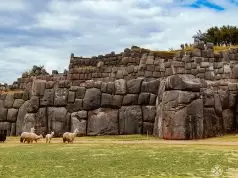


have you any information as to whether or not a trip to Awamanki is worth the time?
We need to decide whether to spend that day in Awamanki or Cuzco. Thank you I’ve read all your blogs and the information is excellent.
Hey Paty,
I am quite sorry, but I do not know what you mean with “Awamanki”. You sure u spelled that right? Googling I only found a women’s cooperative near Cusco.
Yes, that is Awamaki a women’s cooperative leaving from Ollyntaytambo 6 hour tour returning 5 pm. Then leaving early to Cusco to catch a plane at 4pm.
So, I don’t know if instead of spending the whole day going to Awamaki, we should take the time to go to Chinchero, Pisac and sleep in Cusco.
Well Paty,
I really got no personal experience with Awamaki, so I couldn’t say if it’s worth it or not. Sorry. Seeing Pisac definitely is worth it…but that really depends on your itinerary. If you already plan to say other Inca ruins, it might be a bit repetitive ;-)
Thank you so much for taking the time to reply to my comment. I love your blog.
Paty
Hi Norman,
I enjoyed reading your blog – thanks for all the info and pictures.
I’m thinking about 2 weeks in Peru, possibly August 2018 and had been looking at Explora in Sacred Valley (we recently stayed at their hotel in Atacama Desert, Chile and loved it!)
Any comments or comparison you can offer between the two?
Off the top of my head, I was thinking to spend at least 3 nights (their minimum) at Explora and do some of their excursions – Use Belmond at Machu Picchu and maybe Cusco, and possibly continue onto Puno staying at Titilaka; read your review of the Andean Explorer and depending on time, I would rather do that over flying.)
Thanks
Glad you liked my articles. Can’t tell you anything about “Explore”. The only property I ever stayed was the Belmond Rio Sacredo. I also had dinner at the Inkaterre, which also was quite nice!
Thanks for such a detailed description! I am planning for a 2-wk South American visit and your information is very helpful.
Hi Norman, I could’t find where you wrote what hot baths you prefer over those in Aguas Calientes. Do you? Thanx
Here you go: https://www.annees-de-pelerinage.com/get-machu-picchu-bus/
I was talking about Santa Teresa, though it is a little bit off the grid.
Thanks for this geat article. How many days would you recommend spending there ?
A night will be enough, in fact :)
LOVED OLLANTAYYY! go to the Pumamarca ruins also!!! Literally no one goes there and the hike is incredible – a great day long activity with stellar views.
Is there any way to go play in the river? I like to swim, or maybe kayak??
Hey Kathy,
well..swimming might be a bit rough, but there are some companies offering white water rafting :)